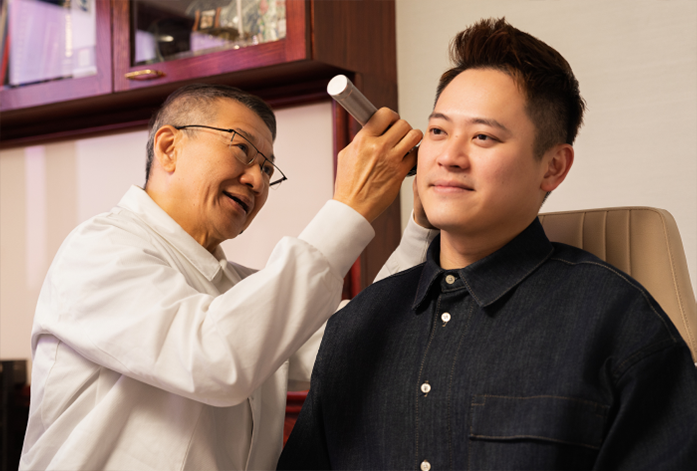Ear Infection: Types, Symptoms, and Treatments in Singapore

In Singapore's hot and humid climate, ear infections are common, especially among children. Untreated cases can lead to serious consequences like temporary hearing loss or developmental delays. Understanding these infections, from symptoms and risks to effective treatment and prevention, can help you make informed decisions, whether for yourself or a loved one.
What Is an Ear Infection?
An ear infection occurs when bacteria, viruses, or fungi cause inflammation in parts of the ear. The most common is otitis media, where the middle ear (the air-filled space behind the eardrum) becomes inflamed. This space connects to the throat via the eustachian tube, which equalises ear pressure and drains fluid. If the tube becomes blocked, fluid may accumulate, providing an ideal environment for infection.
Unlike common earaches caused by external factors like pressure changes or earwax buildup, infections in the middle ear involve deeper inflammation and require targeted treatment. Left unmanaged, they can lead to complications, especially in young children.
How Common Are Ear Infections?
Approximately 5 out of 6 children experience at least one ear infection by age 3, making this one of the leading reasons for paediatric visits to polyclinics and family clinics. This is likely due to children’s developing immune systems and smaller eustachian tubes.
In Singapore, viral infections tend to peak during monsoon seasons, which can increase ear infection rates. Adults are less prone but may still develop infections, often due to chronic sinus problems, allergies, or structural issues affecting eustachian tube function.
What Are the Types of Ear Infections?
The ears are vulnerable to a range of infections, especially in children. Common types include:
Otitis Media (Middle Ear Infection)
This is the most common type of ear infection, affecting the middle ear behind the eardrum. Acute otitis media develops quickly with significant pain, while otitis media with effusion involves persistent fluid that may cause fewer symptoms.
Ear Fungal Infections (Otomycosis)
Humid conditions encourage fungal growth in the ear canal. Symptoms include intense itching, coloured discharge, and sometimes a musty odour. These infections are common among swimmers and those working in humid environments, and they require specialised antifungal treatment.
Swimmer’s Ear (Otitis Externa)
Despite the name, swimmer’s ear can develop without swimming. Otitis externa is an outer ear canal infection often caused by excessive moisture, scratches from cotton buds, or underlying skin conditions like eczema.
What Are the Symptoms of an Ear Infection?
Ear infections are not always obvious, especially in children who cannot describe their discomfort. Recognising these symptoms is important, as untreated infections can escalate quickly.
Symptoms of ear infections among infants and toddlers often include:
- Excessive crying, especially when lying down
- Ear pulling or tugging
- Sleep difficulties
- Fever
- Fluid drainage
- Hearing problems
In older children and adults, common symptoms include:
- Sharp, dull, or burning ear pain
- Fullness sensation
- Muffled hearing
- Fever and general illness
- Headache
- Balance issues
Don't ignore persistent ear pain, hearing changes, or discharge. If you are experiencing these symptoms, it's time to consult an ENT specialist for a proper diagnosis.
What Are the Risk Factors for Ear Infections?
Certain conditions and environmental exposures significantly increase your risk of developing an ear infection. The following are some of the risk factors you should be aware of:
Age
- Children, 6 months to 2 years, face the highest risk due to the anatomy of their eustachian tubes and developing immune systems.Family History
- Inherited anatomical features and immune characteristics can increase susceptibility.Colds
- Upper respiratory infections can block the eustachian tubes, especially in environments with prolonged air-conditioning or crowded public transport.Chronic Illnesses
- Conditions such as asthma, allergies, and immune disorders can raise risk. Dust, haze, and urban pollution can worsen respiratory inflammation.Poor Air Quality or Cigarette Smoke
- Second-hand smoke and haze from regional fires can irritate airways and impair eustachian tube function.
What Are the Complications of Ear Infections?
Ear infections might seem minor and temporary, but if left untreated, they can lead to long-term conditions that may require urgent medical care.
Hearing Loss
- Fluid buildup can cause temporary hearing problems. Severe cases may cause permanent damage.Delayed Speech and Language Development
- Prolonged hearing loss during critical learning stages can affect vocabulary and communication skills in children.Torn Eardrum
- Pressure buildup may perforate the eardrum. Small tears often heal naturally; larger ones may need surgical repair.Spread of Infection
- In rare cases, infections may spread to nearby bone (mastoiditis) or the brain, requiring emergency care.
How Is an Ear Infection Diagnosed?
In Singapore, ENT specialists are well-equipped to diagnose ear infections using specialised tools and tests. These methods allow for early detection, help prevent complications, and ensure the right treatment path.
Tympanometry
A probe measures eardrum movement in response to pressure changes, detecting fluid or structural problems. Alongside this, doctors frequently use an otoscope to visually examine the eardrum's position, colour, and movement for an initial diagnosis.
Audiometry Test (Hearing Test)
This test measures hearing across frequencies, distinguishing between conductive (caused by issues in the outer or middle ear) and sensorineural (from inner ear or nerve damage) hearing loss.
How Is an Ear Infection Treated?
Treatment options for ear infections range from targeted medications to minor surgical procedures. These treatments not only bring relief but also prevent complications that could affect hearing and long-term development, especially in children.
Medication
Antibiotics
- Prescribed for bacterial infections based on age, severity, and bacterial likelihood. It is crucial to complete the full course, even if symptoms improve, to ensure the infection is fully eradicated.Antibiotic or Antifungal Ear Drops
- Used for outer ear or fungal infections common in tropical climates. Treatment may continue for several weeks.Pain Relievers
- Over-the-counter pain relief medication can help manage pain and fever.
Surgical Procedures
Ear Tube Insertion
- Tiny tubes are placed in the eardrums to allow drainage and prevent recurrent infections. Most tubes fall out naturally within 6–12 months.Drainage Procedures
- A common procedure is myringotomy, which creates small eardrum openings to drain accumulated fluid or pus when natural drainage fails.
If you are concerned about an ear infection, schedule a consultation with our ENT specialist today for a detailed evaluation and a personalised treatment plan.
What Can I Do to Prevent Ear Infections?
Preventing ear infections starts with everyday habits. These measures are especially significant for children and those with recurring issues, helping to avoid complications and reduce dependence on medications.
Proper Ear Hygiene
- Keep ears clean and dry without over-cleaning. Do not use cotton buds inside the ear canals. Dry your ears gently after swimming.Managing Allergies and Colds
- Treat allergies promptly, practice good hand hygiene and consider air purifiers during haze periods.Avoiding Triggers
- Limit exposure to cigarette smoke and air pollutants. For infants, always feed them in an upright position to prevent milk from entering the middle ear.Vaccinations
- Staying up to date with pneumococcal and flu vaccines can help protect against certain illnesses that may lead to ear infections.
FAQs on Ear Infection





Dr Lau Chee Chong
Medical Director & Senior Consultant
ENT Surgeon – Ear, Nose, Throat, Head & Neck Surgery
MBBS (S’pore), FRCS (Edinburgh), FAMS (ENT)
Dr Lau Chee Chong is an experienced ear, nose, and throat (ENT) doctor at Mount Elizabeth Centre, treating both adults and children. With over 25 years of specialist experience, he holds surgical and visiting rights at all private hospitals in Singapore.
Dr Lau's practice covers the full spectrum of ENT, head, and neck care—including diagnostic, medical, and surgical management. He has a particular interest and expertise in treating snoring, sleep apnoea, and other sleep-related breathing disorders in both adults and children.








